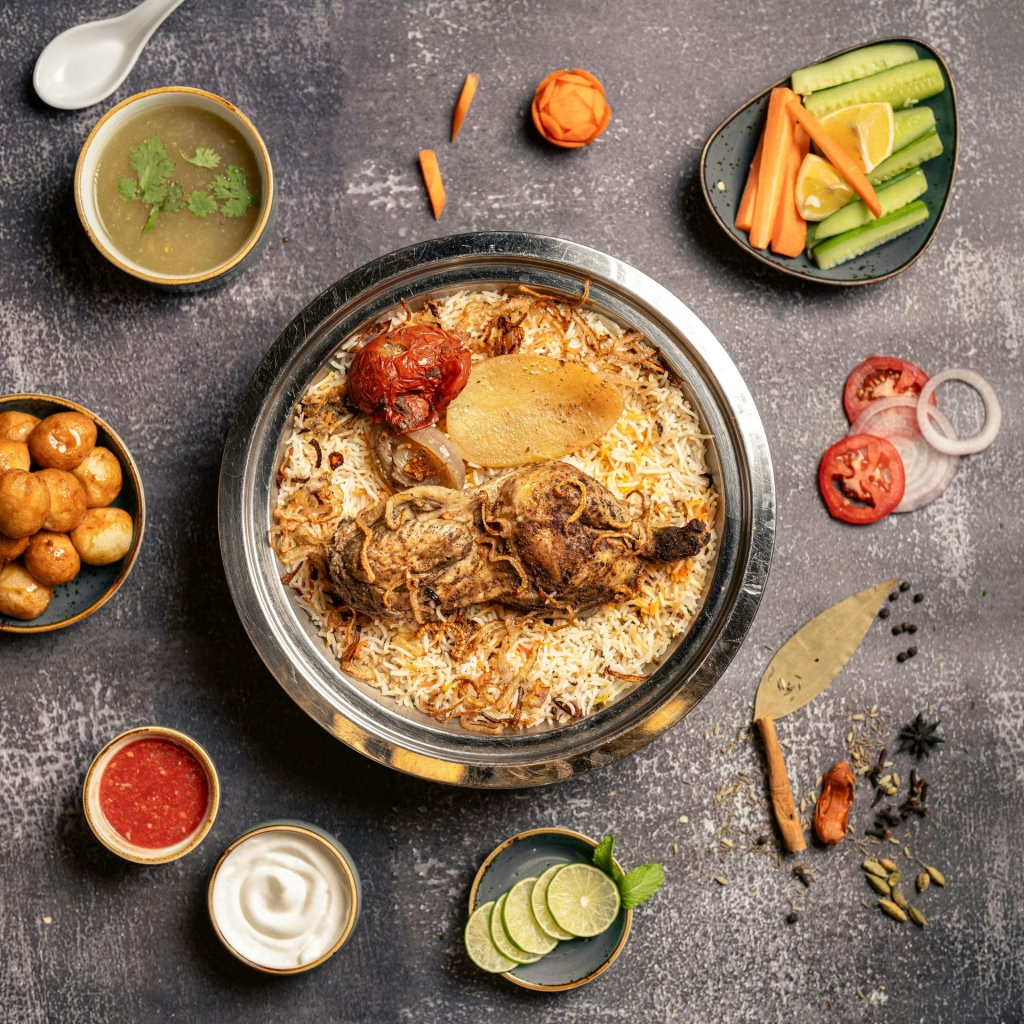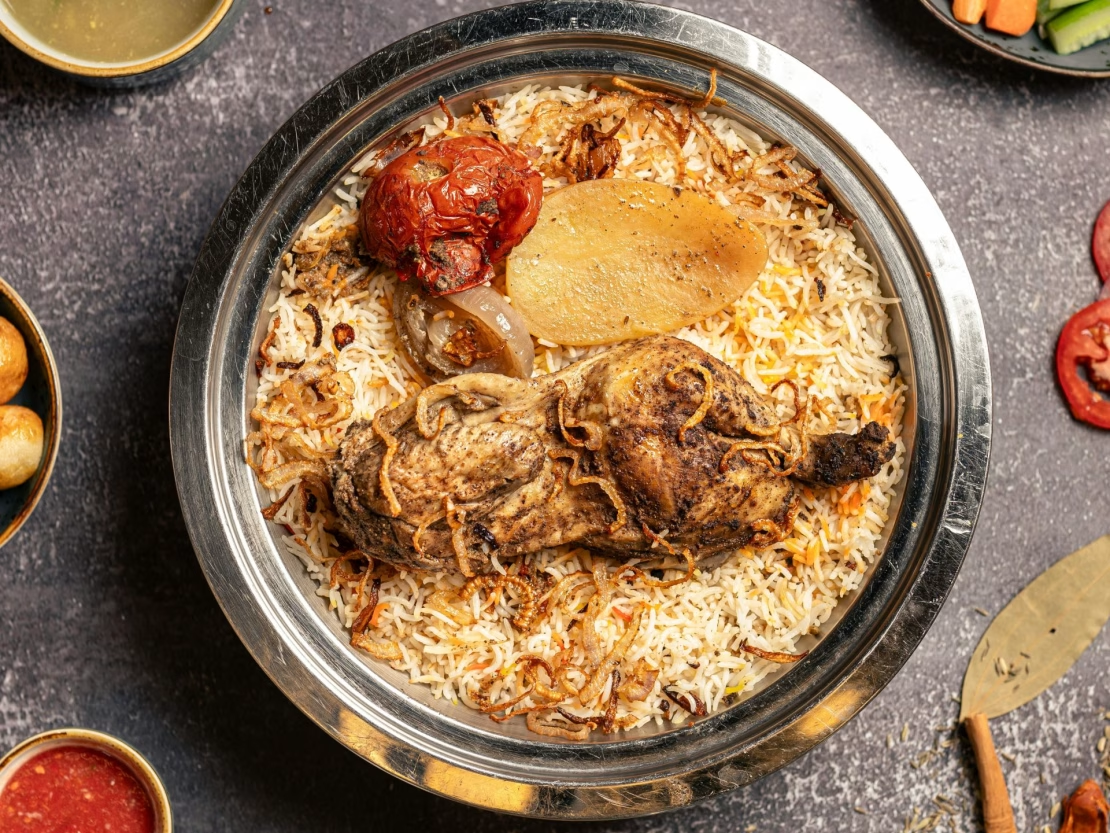Chicken Mandi (Yemen) is more than just a dish; it’s a cultural expression, a culinary treasure, and a celebration of Arabian hospitality.
This fragrant and succulent Yemeni rice dish made with spiced chicken and basmati rice is traditionally slow-cooked in a tandoor or underground oven. Its distinct flavor comes from a unique blend of spices called Hawaij, saffron-infused rice, and the smoky essence imparted by the final coal smoking technique.
Whether you’re hosting a festive gathering or simply craving a Middle Eastern delight, this detailed recipe guide will walk you through everything you need to create the perfect, restaurant-style Chicken Mandi (Yemen) at home.
Table of Contents
Ingredients for Chicken Mandi (Yemen)
For the Chicken Marinade:
- 1 whole chicken (around 1.2–1.5 kg), cut into 4 pieces or 4 leg quarters
- 2 tbsp lemon juice
- 1/2 cup plain yogurt
- 1 tbsp ginger-garlic paste
- 1/2 tsp turmeric powder
- 1 tsp coriander powder
- 1/2 tsp cumin powder
- 1 tsp smoked paprika or Kashmiri red chili powder (for color)
- 1/2 tsp ground cinnamon
- 1/4 tsp ground cloves
- 1/4 tsp ground cardamom
- 1/4 tsp ground nutmeg
- Salt to taste
- 2 tbsp olive oil or ghee
For the Rice:
- 2 cups long-grain basmati rice (rinsed and soaked for 30 minutes)
- 1 large onion, finely sliced
- 1 bay leaf
- 4 cloves
- 4 green cardamoms
- 1 small stick of cinnamon
- 1 star anise (optional)
- 1 dried lemon (loomi), pierced
- 1 tsp cumin seeds
- 1/2 tsp turmeric powder
- 4 cups chicken stock (or water)
- Salt to taste
- A pinch of saffron threads soaked in 2 tbsp warm milk (optional)
For the Coal Smoking:
- 1 piece of natural charcoal
- 1 tsp ghee or butter
- Small aluminum foil cup or a piece of onion skin
Serves
This recipe serves 4–5 people generously.
Step-by-Step Instructions
Step 1: Marinate the Chicken
- In a large bowl, mix yogurt, lemon juice, all ground spices, ginger-garlic paste, olive oil/ghee, and salt.
- Add the chicken pieces and coat them thoroughly with the marinade.
- Cover and refrigerate for at least 2 hours, preferably overnight, for maximum flavor absorption.
Step 2: Cook the Chicken
- Preheat the oven to 200°C (390°F).
- Place the marinated chicken pieces on a baking rack over a foil-lined tray. Roast for 30–35 minutes or until the chicken is nicely browned and cooked through.
- For added smokiness, you may grill it briefly or finish in a hot tandoor-style oven.
Step 3: Prepare the Rice
- Heat 2 tbsp of oil or ghee in a heavy-bottomed pot.
- Add cumin seeds, bay leaf, cardamoms, cloves, cinnamon, and star anise. Sauté until aromatic.
- Add the sliced onions and cook until golden brown.
- Stir in turmeric powder and soaked rice. Mix gently.
- Add pierced dried lemon, chicken stock, and salt.
- Bring to a boil, then reduce heat, cover, and simmer until rice is cooked and fluffy (about 15–18 minutes).
- Once done, gently fluff the rice with a fork and drizzle saffron milk on top. Let it rest covered for 5 minutes.
Step 4: Coal Smoking (Optional but Recommended)
- Heat a piece of charcoal until red hot.
- Place a small aluminum foil cup or onion peel on the rice and place the coal inside.
- Drop a tsp of ghee on the coal and immediately cover the pot with a tight lid.
- Let the smoke infuse for 4–5 minutes, then remove the coal.
Step 5: Assemble the Mandi
- Spread the fragrant rice on a large serving platter or thali.
- Place the roasted chicken pieces on top.
- Garnish with caramelized onions, toasted nuts (like almonds or cashews), and chopped coriander if desired.

Serving Suggestions
- Accompaniments: Serve with Shatta (Yemeni chili sauce), fresh salad, and a side of garlic yogurt dip.
- Traditional Way: Eat it the Yemeni way, served on a large communal platter, eaten by hand.
- Beverage Pairing: Mint lemonade or laban (spiced buttermilk) complements the rich spices beautifully.
Tips for Perfect Chicken Mandi (Yemen)
- Use basmati rice for the best aroma and texture.
- Marinate overnight to allow spices to deeply penetrate the meat.
- Use a pierced dried lemon (loomi) in rice for authentic tangy flavor.
- Add coal smoke only at the end—this replicates the traditional underground tandoor aroma.
- Avoid stirring rice too often to prevent it from becoming mushy.
- Adjust spices based on heat tolerance but do not omit the Hawaij blend (Yemeni spice mix).
- Roast or grill the chicken to get charred edges for that authentic look and taste.
Healthier Alternatives
- Use skinless chicken breasts instead of thighs or legs to reduce fat content.
- Steam or air-fry chicken instead of oven roasting to cut down on oil.
- Brown rice or quinoa can be used instead of white rice for a healthier carb option.
- Low-fat yogurt can replace regular yogurt in the marinade.
- Reduce salt and avoid added butter if on a low-sodium diet.
Creative Variations
- Lamb Mandi: Substitute chicken with lamb shanks or shoulder for a richer flavor.
- Vegetarian Mandi: Use grilled paneer, mushrooms, or tofu as a meat substitute and vegetable broth instead of chicken stock.
- Seafood Mandi: Replace chicken with prawns or grilled fish fillets for a coastal twist.
- Spicy Shatta Glaze: Toss roasted chicken in a chili-lime glaze before serving for an extra kick.
- Nutty Mandi: Add toasted almonds, pine nuts, and raisins to the rice for added texture and sweetness.
Common Mistakes to Avoid
- Skipping the soak: Not soaking the rice can result in uneven cooking.
- Using short-grain rice: It won’t give the fluffy, separated grains typical of Mandi.
- Not marinating long enough: The flavor will remain superficial.
- Over-smoking: Leaving the coal in for too long can make the dish bitter.
- Using too much water: Leads to soggy, sticky rice instead of fluffy grains.
- Undercooking chicken: Especially when using large pieces or whole bird.
- Cooking at high flame: Always simmer rice on low to avoid burning.
History of Chicken Mandi (Yemen)
Mandi is a dish deeply rooted in the Arabian Peninsula, especially in Yemen where it originated. The word “Mandi” is derived from the Arabic word nada, meaning “dew,” referring to the moist, tender texture of the meat. This dish has been passed down through generations, often cooked in a taboon or underground clay oven, where marinated meat is hung above a spiced rice mixture to slowly steam and roast to perfection. The traditional process is both an art and a community affair, where the act of preparing Mandi is just as important as eating it.
Historically, Mandi was considered a dish of celebration, often made for weddings, Eid, or family feasts. The spice blend used, known as Hawaij, evolved based on regional availability, giving each Mandi a slightly different flavor depending on where in Yemen it is made. In rural Yemen, goat or lamb is commonly used, and the dish is typically served on the floor over a large shared platter, reinforcing the region’s values of hospitality and community.
As Yemeni communities spread across the Middle East and beyond, Chicken Mandi (Yemen) gained popularity in countries like Saudi Arabia, UAE, and even India. Today, it can be found in street stalls and fine dining restaurants alike, served with regional adaptations but always retaining its rich aromatic heritage.
FAQs about Chicken Mandi (Yemen)
1. What makes Mandi different from other biryanis or pulaos?
Mandi is traditionally cooked using a tandoor-like underground oven, which gives the rice and meat a unique smoky flavor, and it uses a specific Yemeni spice blend called Hawaij.
2. Can I make Mandi without an oven?
Yes! You can cook the chicken on a stovetop grill pan or in a regular pan and still smoke it using charcoal to achieve that authentic flavor.
3. Is Mandi always made with chicken?
No, it can also be made with lamb, goat, or even fish depending on regional and personal preferences.
4. What is Hawaij spice mix?
Hawaij is a Yemeni blend of spices like cumin, coriander, black pepper, cardamom, turmeric, and cloves used to flavor both the chicken and the rice.
5. Can I use store-bought rotisserie chicken?
Yes, but marinating and roasting fresh chicken gives more authentic flavor.
6. Why is coal smoking important?
It mimics the traditional smoky aroma of underground tandoor cooking, making it a crucial step for authenticity.
7. What if I can’t find loomi (dried lemon)?
You can use lemon zest or a bit of lemon juice, but the dried lemon provides a deeper, fermented citrus flavor.
8. Can I freeze Chicken Mandi?
Yes. Store rice and chicken separately in airtight containers. Reheat gently to maintain texture.
9. Is Chicken Mandi spicy?
Traditionally, it’s mildly spiced with aromatic warmth rather than heat. You can adjust chili as desired.
10. What side dishes go best with it?
Chili garlic sauce (Shatta), cucumber yogurt salad, and pickled vegetables pair excellently.
Chicken Mandi (Yemen) is a dish that unites tradition, flavor, and community in every bite. Whether you’re cooking it for a family dinner or a festive gathering, the aromas of saffron, cardamom, and charcoal smoke will transport you straight to the heart of Arabia. With this detailed recipe guide, you can recreate the magic of Yemeni cuisine in your own kitchen, authentically and effortlessly.
So go ahead, grab your spices, prep your ingredients, and bring home the soul of Yemen with a plate of tender, aromatic Chicken Mandi (Yemen). It’s more than a meal, it’s a culinary journey.


